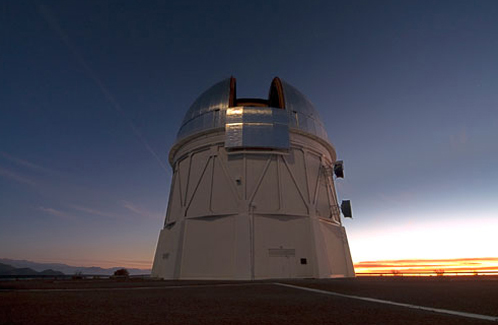Dark Energy under Observation
Excellence Cluster Universe and LMU have joined the Dark Energy Survey
24.11.2010 —
The Excellence Cluster „Origin and Structure of the Universe“ and the Ludwig-Maximilians-Universität (LMU) have joined the „Dark Energy Survey“ (DES). This international observational campaign will start at the end of 2011. The understanding of Dark Energy is one of the key questions in the research of the Universe Cluster. For six astrophysicists and their research groups at the University Observatory of the LMU participation in this large-scale project will provide their research work with important impetus: The membership gives them access to all the observational data of the project and the opportunity to work collaboratively with a strong international team of scientists focused on providing insights into one of the most important questions facing physics today.
The accelerating expansion of the Universe was discovered towards the end of the 1990’s based on observations of very distant supernovae. According to today’s knowledge Dark Energy is considered a possible cause of this accelerating expansion of the cosmos. The aim of DES is to unravel the mystery of Dark Energy with the help of sky surveys. The DES project, in which more than 120 scientists from the USA, Great Britain, Brazil, Spain, and Germany are involved, should start at the end of 2011. The scientists plan to observe for 525 nights over a five-year period.
During this time the highly sensitive “DECam” camera will take more than 150,000 images each of them covering more than 16 times the area of the full moon and collect data from 300 million galaxies, which are found billions of light years away from the earth in the southern sky. DECam will take pictures of each galaxy in five different optical filters. These survey data will be combined with a near-infrared survey being carried out at the ESO VISTA telescope. DES will deliver deep multi-color images of galaxies and quasars in the Universe. Furthermore, the survey will enable detection of sources that are more than ten times fainter than those detected by the most sensitive previous large sky surveys.
The heart of the campaign comprises a 570-megapixel digital camera (DECam), which is being mounted on the Blanco 4-meter telescope at the Cerro Tololo Observatory in the Chilean Andes together with a state of the art data management system that will use supercomputers in the US and in Germany to process the sky images into precise catalogs of the brightness and shape of each galaxy observed.
The researchers are currently discussing different forms of Dark Energy and whether Dark Energy changes with time. Compared to previous observational campaigns, DES will be the first to study the Dark Energy question using multiple independent astrophysical methods. To study Dark Energy, astrophysicists have to make a detour via Dark Matter, a further component of the Universe. The DES observations of galaxies will use gravitational lensing to enable the distribution of Dark Matter to be reconstructed; these data will in turn provide the scientists with information on the physical properties of Dark Energy. In addition, the DES will enable snapshots of the large-scale distribution of galaxies and galaxy clusters stretching back more than 10 billion years in time. These snapshots allow the DES scientists to measure how large-scale structure is evolving in time and thereby infer the properties of the Dark Energy. A further component of the study involves the discovery of several thousand new Supernovae at large distances, which will provide new distance measurements and direct tests of how the cosmic acceleration has changed over time.
“DES will deliver a combination of independent tests on the nature of the cosmic acceleration or Dark Energy, thus setting a new standard for next generation missions”, says Professor Joseph Mohr, one of the DES members from the University Observatory, LMU. “Upcoming observational campaigns such as Euclid, LSST and the SKA have followed in DES's footsteps by adopting a similar multi-pronged approach to studying the nature of the Dark Energy.” Mohr is a co-founder of the DES project and is the project scientist for the data management project and the co-coordinator of the working group charged with executing the galaxy cluster study of the Dark Energy.
Adds his colleague Professor Jochen Weller, leader of the group “Observational Astrophysics” at the Cluster: “DES will enable us to measure the distribution and images of more than 300 million galaxies. This material will allow my research group to evaluate different models of the accelerated expansion of the Universe. Maybe we will find the answer to the question, whether or not Einstein’s theory of gravity can be applied to very large distances.” Weller joined DES while a postdoc at Fermilab, and he is currently co-coordinating the science working group that is charged with combining the results from the four independent tests.
Other new members of DES at LMU include Professor Ralf Bender, Professor Andreas Burkert, Dr. Roberto Saglia and Dr. Stella Seitz. Their research groups are also involved in these DES studies with emphasis on gravitational lensing, the use of new spectroscopic instruments on the Very Large Telescope (VLT) to further study interesting sources discovered by DES, and in the production of large scale numerical simulations of structure formation and evolution in the Universe that can be directly compared to the DES measurements.
Additional information can be found on our website www.universe-cluster.de
Media contact: Barbara Wankerl, Excellence Cluster Universe, Technische Universität München, Tel: +49.89.35831-7105, E-Mail: barbara.wankerl@universe-cluster.de
Scientific contact: Prof. Dr. Jochen Weller, Excellence Cluster Universe, Ludwig-Maximilians-Universität, Tel: +49.89.35831-7138, E-Mail: jochen.weller@usm.lmu.de, www.usm.uni-muenchen.de/people/jweller/index.html










